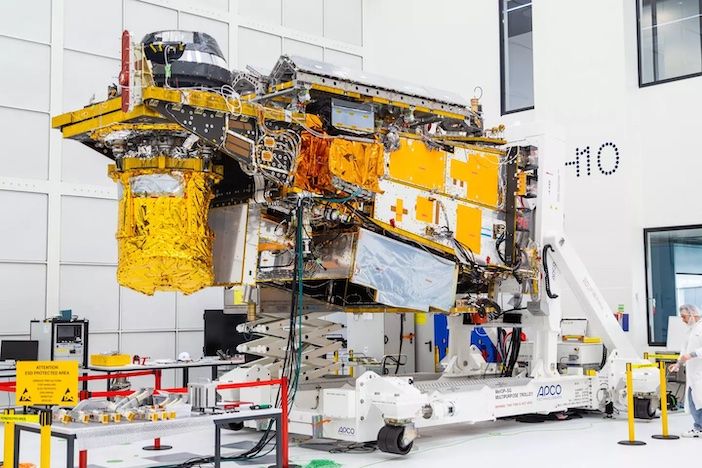The first pair of second-generation weather satellites built by Airbus, MetOp-SG A and B have entered their testing phase
The Airbus built satellite twins, MetOp-SG A and B will provide meteorological data that will substantially improve daily weather forecasts at regional and global levels.
In addition the satellites have multiple instruments on-board for climate monitoring, atmospheric chemistry and other services such as air pollution, hydrology, land use, and oceanography that will help prevent climate change.
MetOp-SG comprises two satellite series, with three units in each series. Flying in a polar orbit, they are able to observe the entire planet in fine detail providing vital information on storms, volcanoes, landslides, wildfires, and other natural events on Earth.
The A series carries optical and atmospheric instruments, essential to identify specific types of clouds from space or determine storm intensity. The B series hosts microwave instruments able to measure through cloud cover to detect precipitation, temperature in different layers of the atmosphere, and surface characteristics like ocean surface winds.
MetOp-SG A final tests
The integration of the first MetOp-SG-A, built at Airbus in Toulouse, France was finalized last October with the installation of the Infrared Atmospheric Sounding Interferometer – New Generation (IASI-NG), the most complex of the satellite’s instruments. Four times more precise than its predecessor, IASI-NG will determine temperature and water vapour profiles in the atmosphere, record ocean surface and land temperatures and monitor a wide range of chemical compounds and other key variables for climate research, including greenhouse gases, desert dust and cloud cover.
IASI-NG will be a powerful tool for weather forecasting and to monitor the climate’s health at any moment in time to secure life and property on Earth. The spacecraft has completed its mechanical tests proving the satellite can withstand the harsh vibrations of launch and the solar panels have been deployed. Next up, the thermal vacuum test in space-like conditions to make sure the spacecraft can operate in space.
Integration of MetOp-SG-B was completed last week at Airbus in Friedrichshafen, Germany with the installation of the advanced scatterometer, and the spacecraft is about to undergo its environmental test campaign. This scatterometer provides double the resolution than the previous, and will be used to monitor ocean winds and continental ice sheets, and to check land-surface soil moisture – a key driver of water and heat fluxes between the ground and the atmosphere.
Scatterometers have been used to study unusual weather phenomena such as El Niño, the long-term effects of deforestation and changes in sea-ice masses around the poles. All of which play a central role in monitoring climate change.
Airbus is leading an industrial consortium comprising of more than 110 companies in 16 European countries and Canada for the MetOp-SG missions.
The first launch of the MetOp-SG mission is scheduled for 2025 after completion of satellite level testing.
The nominal operational lifetime of each of the three MetOp-SG satellites is 7.5 years, and will ensure full operational coverage over a 21-year period. MetOp-SG is a cooperative undertaking between the European Space Agency (ESA) and EUMETSAT, the European Organisation for the Exploitation of Meteorological Satellites.
Currently, Earth-observation satellites are at the forefront of monitoring deforestation, rising sea levels and greenhouse gas emissions in the atmosphere, all having a key impact in climate behaviour. Today, 20 Airbus satellites are involved in climate change monitoring and an additional 20 are in development that will measure key atmospheric constituents, land and sea topography, air quality, temperature and humidity, and snow and ice coverage.





